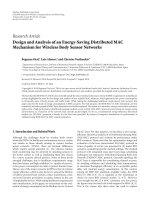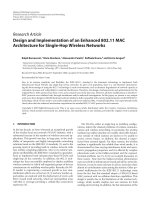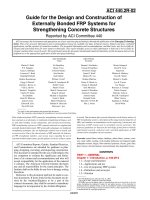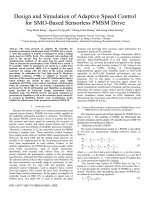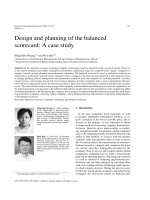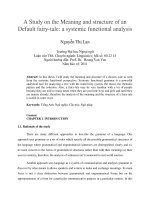Fundamental design and study of an evaporative cooling system
Bạn đang xem bản rút gọn của tài liệu. Xem và tải ngay bản đầy đủ của tài liệu tại đây (4.04 MB, 142 trang )
FUNDAMENTAL DESIGN AND STUDY OF
AN EVAPORATIVE COOLING SYSTEM
XU JIA
(B.Eng., SCU)
A THESIS SUBMITTED
FOR THE DEGREE OF MASTER OF
ENGINEERING
DEPARTMENT OF MECHANICAL ENGINEERING
NATIONAL UNIVERSITY OF SINGAPORE
2014
DECLARATION
I hereby declare that the thesis is my original work
and it has been written by me in its entirety.
I have duly acknowledged all the sources of
information which have been used in the thesis.
This thesis has also not been submitted for any
degree in any university previously.
XU JIA
12 May 2014
ACKNOWLEDGEMENTS
ACKNOWLEDGEMENTS
First of all, I would like to thank my supervisors Dr. Chua Kian Jon, Ernest and Dr.
Yang Wenming for their patience and continual instruction throughout my pursuing of
master degree. Especially, I am greatly indebted to Dr. Chua Kian Jon, Ernest, who
played an important role in providing me with knowledge and guide related to my
research program. Without his enlightened advice, I cannot keep pace in the right
direction and complete my work.
Next, I would like to extend my gratitude to my friends in TPL1, working with
them offers me with great happiness. Sometimes when I felt frustrated, they would
come and comfort me, arousing my confidence in the research again. Their sincere help
and instructive suggestion are the encouragements that keep me going. In particular, I
want to thank my senior partner Mr. Cui Xin for his constructive advice and good
friendship between us.
Finally, I would offer my special thanks to my parents. Due to their selfless
financial and moral support, I am able to fulfill my dream to study in NUS. They put a
lot of energy on me, which makes them have no time to care themselves, all I want is
that they could be healthy enough to receive my moral obligation. I also want to thank
my beloved girlfriend Zhou Shan. Because of her well understanding, I can study
abroad comfortably while keeping our relationship going.
Thank you everyone for whatever you have done for me.
i
TABLE OF CONTENTS
TABLE OF CONTENTS
ACKNOWLEFGEMENT ............................................................................................... i
TABLE OF CONTENTS ...............................................................................................ii
SUMMARY ................................................................................................................... v
LIST OF TABLES .......................................................................................................vii
LIST OF FIGURES ................................................................................................... viii
LIST OF SYMBOLS .................................................................................................... xi
Chapter1. Introduction ................................................................................................... 1
1.1 Background and motivation ................................................................................. 1
1.1.1 Direct evaporative cooling system ................................................................ 3
1.1.2 Indirect evaporative cooling system ............................................................. 4
1.2 Objectives and approach ...................................................................................... 6
1.3 Outline of thesis ................................................................................................... 7
Chapter2. Literature review ........................................................................................... 9
2.1 Direct evaporative cooling system (DECS) ......................................................... 9
2.2 Indirect evaporative cooling system (IECS) ...................................................... 10
2.2.1 Single stage IECS ....................................................................................... 10
2.2.2 IECS combined with DECS ........................................................................ 11
2.2.3 IECS combined with desiccant system ....................................................... 13
2.2.4 IECS combined with natural heat sinks ...................................................... 14
2.3 Plate type IECS .................................................................................................. 15
2.3.1 Theoretical study......................................................................................... 15
2.3.2 Flow arrangements ...................................................................................... 18
2.3.3 Material for evaporative media ................................................................... 23
2.3.4 Gap and objective ....................................................................................... 24
2.4 Tubular IECS ..................................................................................................... 25
2.4.1 Theoretical study......................................................................................... 26
2.4.2 Fins study .................................................................................................... 28
2.4.3 Application of tubular IECS ....................................................................... 29
2.4.4 Geometry of tube banks .............................................................................. 30
2.4.5 Semi-indirect evaporative cooler ................................................................ 31
2.4.6 Gap and objective ....................................................................................... 34
Chapter3. Computational model .................................................................................. 36
ii
TABLE OF CONTENTS
3.1 Plate type IECS .................................................................................................. 36
3.1.1 Governing equations ................................................................................... 36
3.1.2 A general formation of governing equations .............................................. 44
3.1.3 Heat and mass transfer coefficients ............................................................ 47
3.1.4 Boundary conditions ................................................................................... 49
3.1.5 Air properties .............................................................................................. 50
3.1.5.1 Saturated vapor pressure ...................................................................... 51
3.1.5.2 Humidity ratio and relative humidity ................................................... 52
3.1.5.3 Enthalpy ............................................................................................... 52
3.1.5.4 Wet bulb temperature ........................................................................... 53
3.1.5.5 Air thermodynamic properties ............................................................. 53
3.1.6 Simulation procedure .................................................................................. 54
3.2 Flat Tubular IECS .............................................................................................. 56
3.2.1 Governing equations ................................................................................... 56
3.2.2 Boundary conditions ................................................................................... 60
3.2.3 Flat tube geometry ...................................................................................... 61
3.2.4 Simulation procedure .................................................................................. 66
Chapter4. Results and discussion ................................................................................. 68
4.1 Validation of the model ..................................................................................... 68
4.2 Plate type IECS .................................................................................................. 72
4.2.1 Typical simulation of an IECS .................................................................... 73
4.2.2 Effect of inlet temperature of primary air ................................................... 75
4.2.3 Effect of inlet dry bulb temperature of secondary air ................................. 76
4.2.4 Effect of inlet wet bulb temperature of secondary air................................. 77
4.2.5 Effect of velocity of primary air ................................................................. 78
4.2.6 Effect of velocity of secondary air .............................................................. 79
4.2.7 Effect of plate geometry.............................................................................. 80
4.2.8 Effect of channel width ............................................................................... 82
4.2.9 Effect of wetting condition ......................................................................... 83
4.2.10 Effect of Lewis factor ............................................................................... 85
4.2.11 Effect of flow pattern ................................................................................ 86
4.3 Flat Tubular IECS .............................................................................................. 89
4.3.1 Effect of tube number in a column ............................................................. 91
iii
TABLE OF CONTENTS
4.3.2 Effect of air properties ................................................................................ 92
4.3.2.1 Effect of temperature of inlet primary air ............................................ 93
4.3.2.2 Effect of dry bulb temperature of inlet secondary air .......................... 93
4.3.2.3 Effect of wet bulb temperature of inlet secondary air.......................... 94
4.3.3 Effect of tube wettability ............................................................................ 95
4.3.4 Effect of tube dimension under the condition of constant primary and
secondary air velocities .............................................................................. 97
4.3.4.1 Tube long axis length ........................................................................... 97
4.3.4.2 Tube short axis length .......................................................................... 99
4.3.4.3 Effect of relative longitudinal pitch ................................................... 100
4.3.4.4 Effect of relative transversal pitch ..................................................... 102
4.3.4.5 Effect of tube length........................................................................... 103
4.3.5 Effect of tube dimension under the condition of constant flow rates of
primary and secondary air ........................................................................ 104
4.3.5.1 Tube long axis length ......................................................................... 105
4.3.5.2 Effect of tube short axis length .......................................................... 106
4.3.5.3 Effect of relative longitudinal pitch ................................................... 108
4.3.5.4 Effect of relative transversal pitch ..................................................... 109
4.3.5.5 Effect of tube length........................................................................... 111
4.3.6 Optimization of a tubular IECS ................................................................ 113
Chapter5. Conclusion and recommendations ............................................................ 115
5.1 Conclusion ....................................................................................................... 115
5.1.1 Plate type IECS ......................................................................................... 115
5.1.2 Flat Tubular IECS ..................................................................................... 117
5.2 Recommendations for the future work ............................................................ 118
Bibliography .............................................................................................................. 121
iv
SUMMARY
SUMMARY
A lot of works have been conducted on the analysis of an IECS in order to reveal
its cooling mechanism. According to the existing research, many versions of
mathematical models of IECS are developed, among which many are fact calculations
which sacrifice the accuracy for the simplicity, while others consider only certain
aspects due to the complexity of the IECS. Furthermore, most of the studies were based
on the counter-flow configuration, in which secondary air flows counter/parallel to the
primary air, and a few theoretical investigations focused on the cross-flow without a
solid validation. Therefore, an accurate computational model that comprehensively
describes the heat and mass transfer process happened in a cross-flow IECS is highly
demanded. Besides, no study has been found on the IECS employing flat tubes, which
is a reformation of the regular plate type structure.
To explore the mechanism of an IECS, initially a pack of plates are used as the
heat and mass medium for an indirect evaporative cooling system (IECS), in which
primary and secondary air flow in a cross direction while water is sprayed from the
top nozzles. A two-dimensional model is developed to describe the heat and mass
transfer process happened in the system. After comparing the simulation results with
existing experimental results, the small deviation proves the feasibility of proposed
model. Then important parameters, such as air flow rates, diameter of plates, air
properties are tested to understand their effect on the system cooling effectiveness. At
the meantime, Lewis factor and surface wettability are considered as two determining
parameters and their influences on the system performance are carefully analyzed.
v
SUMMARY
The results indicated that key factors like wet bulb temperature of secondary air and
wettability of the wet channel lay a great effect on the cooling performance. Moreover,
the flow patterns of three streams are also altered to check which one is most suitable
for achieving the lowest temperature.
On the other hand, the model has changed to tubular system with the application
of flat tube which has several distinct advantages over other geometries when applied
in an IECS. During the operation, primary air flows in the tube along the axis while
the secondary air flows across the external surface of the tube bank in a cross-flow
direction to the primary air and in a counter-flow direction to the water film. In order
to understand the mechanism of flat tubular indirect evaporative cooler, a numerical
model is developed to predict the fluid temperature distributions along the flow length.
Then influential parameters consisting of tube arrangement, geometry and air
properties are changed to study their effects on the cooling performance in terms of
wet bulb efficiency and air pressure drop. In the end, depending on the investigations,
an optimization of tubular IECS is achieved with high efficiency and low pressure
drop.
vi
LIST OF TABLES
LIST OF TABLES
Table 2.1 Summary of cross-flow type IECS………………………………………...22
Table 3.1 List of symbols for the general governing equations of parallel/counter-flow
...................................................................................................................... 45
Table 3.2 List of symbols for the general governing equations of cross-flow
configuration ................................................................................................ 46
Table 3.3 List of heat resistance in the overall heat transfer coefficients .................... 47
Table 4.1 Comparison of the model with first experiment data .................................. 69
Table 4.2 Comparison of proposed model with third experiments .............................. 72
Table 4.3 Simulated condition for the tubular IECS ................................................... 91
Table 4.4 Optimized size for a tubular IECS ............................................................. 113
vii
LIST OF FIGURES
LIST OF FIGURES
Figure 1.1 Wet pads used in horticulture [3] ................................................................. 3
Figure 1.2 Direct evaporative cooling. (a) Typical configuration of direct evaporative
cooling system. (b) Psychrometric chart representation [4] ........................ 4
Figure 1.3 Indirect evaporative cooling. (a) Typical configuration of indirect
evaporative cooling system. (b) Psychrometric chart representation [4] ..... 5
Figure 2.1 Configuration of indirect evaporative cooling system with secondary air
coming from (a) ambient air, (b) return air, (c) a fraction of primary air, and
their corresponding process on psychrometric chart. ................................ 21
Figure 2.2 Configuration of a tube sized IECS ............................................................ 26
Figure 2.3 Working principle of semi-indirect evaporative cooler.............................. 33
Figure 2.4 Configuration of flat tube indirect evaporative cooling system ................. 35
Figure 3.1 A schematic view of the studied model with (a) 3-D view of dry and wet
passages, (b) 2-D view of the system facade ............................................. 37
Figure 3.2 Amplification of a control element............................................................. 39
Figure 3.3 Four types of flow arrangement of parallel/counter-flow configuration. P Primary air, W - Water film, S - Secondary air ......................................... 45
Figure 3.4 Flow arrangement of cross-flow configuration. ......................................... 46
Figure 3.5 Schematic view of heat resistances between dry and wet channels ........... 47
Figure 3.6 Flowchart of the simulation procedures of a plat type IECS...................... 55
Figure 3.7 Schematic view of one flat tube ................................................................. 57
Figure 3.8 Tube bank dimension and layout in the system.......................................... 57
Figure 3.9 Enlarged view of a selected control element in flat tubular IECS ........... 60
Figure 3.10 Flow chart for the simulation of a flat tubular IECS. ............................... 67
Figure 4.1 Comparison of the proposed model with the second experiment under
condition (a) flow volume of primary is 200m3/h; (b) flow volume of
primary is 300m3/h; (c) flow volume of primary is 400m3/h ................. 70
Figure 4.2 Parameter distributions in a plate type IECS under typical conditions ...... 74
viii
LIST OF FIGURES
Figure 4.3 Effect of inlet temperature of primary air................................................... 75
Figure 4.4 Effect of inlet dry bulb temperature of secondary air................................. 76
Figure 4.5 Effect of inlet wet bulb temperature of secondary air ................................ 77
Figure 4.6 Effect of inlet velocity of primary air ......................................................... 79
Figure 4.7 Effect of inlet velocity of secondary air ..................................................... 80
Figure 4.8 Effect of plate length on the cooling performance ..................................... 81
Figure 4.9 Effect of plate height on the cooling performance ..................................... 82
Figure 4.10 Effect of flow channel width .................................................................... 83
Figure 4.11 Effect of wetting condition on the system cooling performance .............. 84
Figure 4.12 Effect of Lewis factor on the cooling performance .................................. 85
Figure 4.13 Humidity ratio of outlet secondary air when changing Lewis factor ....... 86
Figure 4.14 Primary air and water film temperature distribution along the flowing
direction of two flow patterns .................................................................. 88
Figure 4.15 Humidity distribution of secondary air along the flowing direction of two
flow patterns............................................................................................. 89
Figure 4.16 A schematic view of flat tube bank dimension ........................................ 90
Figure 4.17 Effect of tube number in a column. .......................................................... 92
Figure 4.18 Effect of inlet temperature of primary air................................................. 93
Figure 4.19 Effect of dry bulb temperature of inlet secondary air ............................... 94
Figure 4.20 Effect of relative humidity of inlet secondary air ..................................... 95
Figure 4.21 Effect of surface wettability on the cooling performance ........................ 96
Figure 4.22 Effect of tube long axis length with constant air velocities ...................... 98
Figure 4.23 Effect of tube short axis length with constant air velocities ................... 100
Figure 4.24 Effect of relative longitudinal pitch with constant air velocities. ........... 101
Figure 4.25 Effect of relative transversal pitch with constant air velocities. ............. 103
Figure 4.26 Effect of tube length with constant air velocities ................................... 104
ix
LIST OF FIGURES
Figure 4.27 Effect of tube long axis length with constant air flow rates ................... 106
Figure 4.28 Effect of tube short axis length with constant air flow rates .................. 107
Figure 4.29 Nusselt number of primary and secondary air while changing tube short
axis length at constant flow rate............................................................. 108
Figure 4.30 Effect of relative longitudinal pitch with constant air flow rates. .......... 109
Figure 4.31 Effect of relative transversal pitch with constant air flow rate. .............. 110
Figure 4.32 Nusselt number of secondary air when changing relative transversal pitch
with constant air flow rates .................................................................... 111
Figure 4.33 Effect of tube length with constant flow rates ........................................ 112
Figure 4.34 Average outlet temperature of primary air of each tube with optimization
size ......................................................................................................... 114
Figure 4.35 Psychrometric parameters of secondary air during the flow across the tube
bundle. .................................................................................................... 114
x
LIST OF SYMBOLS
LIST OF SYMBOLS
Nomenclature
Ac
frontal area of flat tube( m 2 )
a
tube long axis length ( m )
b
tube short axis length ( m )
c
specific heat capacity at constant pressure ( J (kg K ) )
D
diffusion coefficient ( m2 s )
Dh
degree of humidity ( g kg )
dehy
hydraulic diameter ( m )
deeq
equivalent diameter ( m )
f
friction factor
h
convective heat transfer coefficient ( W (m2 K ) )
hd
convective mass transfer coefficient ( kg (m2 s) )
g
gravity ( N kg )
i
specific enthalpy ( J kg )
i0
specific enthalpy of vapor at 0C ( J kg )
K
heat transfer coefficient ( W (m2 K ) )
Lx
system length ( m )
Ly
system height ( m )
Le
Lewis number
Le f
Lewis factor
m
mass flow rate ( kg s )
N
number of plates or tubes
xi
LIST OF SYMBOLS
Nu
Nusselt number
P
primary air or tube perimeter ( m ) or vapor partial pressure ( Pa )
Pr
Prandtl number
P
pressure drop ( Pa )
Q
heat transfer rate ( W )
Rf
fouling factor
RH
relative humidity
Re
Reynolds number
r
relative pitch
S
secondary air or tube spacing ( m )
Sc
Schmidt number
St
Stanton number
Stm
mass transfer Stanton number
T
temperature ( C )
V
volume flow rate ( m3 s )
W
water film or humidity ( kg kg )
v
velocity ( m s )
x
infinitesimal length along flowing direction (m)
z
channel width ( m )
Greek letters
thermal diffusivity ( m2 s )
density ( kg m3 )
thickness ( m )
surface wetting condition
dynamic viscosity ( kg (m s) )
xii
LIST OF SYMBOLS
thermal conductivity ( W (m K ) )
efficiency
water linear flow rate ( kg (m s) )
variation
Subscripts
a
secondary air
c
calculated results
dp
dew point
i
inlet
k
Kelvin temperature
l
longitudinal or latent heat
lam
laminar flow
o
outlet
p
primary air
s
saturated/saturation
t
transversal
tur
turbulent flow
v
vapor
w
water film
wb
wet bulb
ws
water and secondary air interface
x
x axis direction
y
y axis direction
xiii
Chapter 1. Introduction
Chapter 1. Introduction
1.1 Background and motivation
Massive and excess use of energy has raised people’s concern on the limiting
energy resources, deterioration of the global climate as well as the disappearance of
ozone layer. It is well-known that three parts are accounting for the energy use, which
are industry, transport and architecture, in which architecture consumes about 20-40
percent of total energy, higher than the other two parts. Among architectural section,
heating ventilation and air conditioning (HVAC) system takes nearly half the energy
consumption, which means it accounts for one quarter of total energy [1]. With the
increasing global temperature, proliferation of building area and demands for higher
comfort conditions, this figure is definitely going to become larger. Therefore, it is
urgent to improve the energy efficiency of the HVAC system and promote new
technology to replace conventional system for decreasing electrical consumption and
the release of CO2 during the operation.
Conventionally, mechanical compressor refrigeration is the main source for air
conditioning, which consists of an evaporator, a compressor, a condenser and an
expansion valve. The theory of its operation is reverse Carnot cycle, depending on the
flowing of refrigerants like R-22, R134a within the system. In an evaporator, the
refrigerant absorbs heat from an exchanger by changing its state from liquid into
vapor. Afterwards, based on the high pressure caused by compressor, the refrigerant
vapor becomes over saturated and then being delivered to a condenser, in which it
transfers energy to the surroundings and turns back into liquid state. After leaving
1
Chapter 1. Introduction
condenser, the refrigerant flows across an expansion valve while reducing high
pressure and going back to an evaporator to fulfill the cycle. Owing to the wonderful
cooling function, this process has been maintained and improved for a long time.
Right now, the low cost, mature technology and good stability explain why it still
dominates the air conditioning market. However, during the working process, the
compressor consumes a lot of energy and in order to better transfer heat between
surroundings and evaporators and condensers, other auxiliary equipment needs to be
installed. In this way, the high dependence on electricity together with the emission of
Chlorofluorocarbons (CFC) makes the mechanical compressor refrigeration an
unsustainable and environmentally unfriendly strategy, letting evaporative cooling
come into sight.
Actually, evaporative cooling had its birth around one thousand years ago
invented in ancient Egypt. At that time, porous pots and ponds covered with a wet
cloth were often used to preserve food against hot weather and some water chutes
were also integrated into walls to keep the inside space cool [2], due to the
evaporation of water when air flowed through. This fantastic technique was soon
spread into other hot and arid places. Nowadays, the application of evaporative
cooling can be seen in many places. For example, Figure 1.1 shows a pack of wet
pads combined with a building, above which water is sprayed with nozzles. It cools
the outside hot air which flows through and afterwards delivers cool and humid fresh
air to the conditioned space. This is a common equipment that used in horticulture and
agriculture fields and widespread in desert place. Still, the phenomenon of
2
Chapter 1. Introduction
evaporative cooling frequently happens to ourselves, for example when we climb out
a swimming pool or after a severe activity, we would feel cold with the evaporation of
water and sweat on us. Therefore, the simple structure as well as highly utilization of
natural energy allows the evaporative cooling to be promising.
Figure 1.1 Wet pads used in horticulture [3]
1.1.1. Direct evaporative cooling system
Evaporative cooling system cools hot fluid by applying the vaporization of water
which allows plenty of heat transfer away from hot fluid. According to the operation
process of evaporative cooler, it normally can be divided into two types: direct and
indirect evaporative cooling system. Direct evaporative cooling system (DECS) which
is shown in Figure 1.2(a) maintains primary air flowing through the wet channel,
resulting in the direct contact of air with water film. During the process, water
evaporates after absorbing heat and then being carried along with primary air.
Therefore the hot air is cooled and humidified. The working process on the
psychrometric chart is depicted on Figure 1.2(b). As can be seen, the hot air is
3
Chapter 1. Introduction
adiabatically cooled from state 1 to state 2 and lastly to the saturation state 1’,
indicating that along the way, air loses its sensible heat while increasing the moisture
content.
Figure 1.2 Direct evaporative cooling. (a) Typical configuration of direct
evaporative cooling system. (b) Psychrometric chart representation [4]
1.1.2. Indirect evaporative cooling system
Indirect evaporative cooling system (IECS) separates primary air from sprayed
water by installing dry and wet channels. Thus primary air is delivered in the dry side
of the heat exchanger, meanwhile secondary air also known as the working air flows
across the wet side, in a direct contact with sprayed water. Through the process, heat
released from primary air is transferred to the wet channel and then absorbed by the
water film covered at wet surface. The resulted water evaporation is taken away by
the secondary air which then is discharged to the ambient. The basic configuration of
indirect evaporative cooling system is shown in Figure 1.3(a).
Figure 1.3(b) clearly describes the working principle of indirect evaporative
cooling system on the psychrometric chart. As it is shown, the state of primary air
4
Chapter 1. Introduction
moves from point 1 to 2, only decreasing the temperature without changing the
humidity, which refers to the amount of water vapor contained in the air. Since higher
humidity would prevent people from cooling by inhibiting sweater on the skin surface
to vaporize, water amount directly determines the comfort condition of residences.
From this point of view, indirect evaporative cooling system appears to be better than
the direct evaporative cooling.
Figure 1.3 Indirect evaporative cooling. (a) Typical configuration of indirect
evaporative cooling system. (b) Psychrometric chart representation [4]
On the other hand, the secondary air is unadiabatically cooled from point 1 to the
saturation curve point 1’ and then goes along the saturation line until it is finally
discharged to the outside. The starting condition of both air streams are at the same
points because of the use of outside air as the secondary air. When return air from
conditioned space is applied, the starting point of the secondary air would not be the
same as that of primary air. However, the wet bulb temperature of secondary air must
lower than outlet temperature of primary air in order to maintain the heat and mass
transfer. That is because the difference between temperature of primary air and wet
5
Chapter 1. Introduction
bulb temperature of secondary air is the impetus for cooling. Since the ideal lowest
temperature that primary air could achieve is the wet bulb temperature of inlet
secondary air as is shown in Figure 1.3(b), therefore, wet bulb effectiveness ( wb ), the
ratio between the actual temperature drop of the primary air and its ideal maximum
temperature drop, is more reasonable for the evaluation of an IECS [5].
wb
t pi t po
t pi tai ,wb
(1-1)
1.2 Objectives and approach
The primary objective of this investigation is to develop a numerical model for
simulating the cooling performance of an indirect evaporative cooling system with
cross-flow arrangement, where return air is applied as the secondary air for the
purpose of recovering heat. To do that, the mechanism related to the heat and mass
transfer process involved inside is comprehensively analyzed. Moreover, for a real
representation of IECS, conditions including variation of water film temperature
along the flowing path, Lewis factor and surface wetting condition are embedded into
the model instead of simply introducing an easy factor to represent them. Different
from previous fast-calculation methods which sacrifice the accuracy for simplicity, by
doing this the accuracy of proposed model is greatly improved. Then, the cooling
performance of the entire system is displayed in terms of temperature distribution,
humidity distribution and system wet bulb efficiency.
For a better understanding of the cooling mechanism of a plate type IECS, the
second objective is to study the influence of key factors and their contributions to the
6
Chapter 1. Introduction
variation of cooling performance. To do that, extensive computational investigations
have to be carried on the factors including system operation conditions, plate
geometry, surface wettability as well as flow arrangement of a cross-flow IECS. After
that, results are carefully examined and analyzed for the discussion of their
characteristics in order to understand their working mechanism, offering instructions
for the future study.
The third objective is to explore the characteristics of a tubular IECS which is
equipped with flat tubes based on the findings from plate type IECS. In the
investigation, numerical simulations have been performed to reveal the system
cooling performance. To discern the effects of influential parameters, tubular
geometry is comprehensively studied in terms of system efficiency and pressure drop.
Moreover, after the discussion of their influence, an optimized tubular IECS is
achieved in order to provide guidelines for the future work.
1.3 Outline of thesis
In this thesis, Chapter 1 mainly has illustrated the background and motivation of
the necessity to study an evaporative cooling system, which normally consists of direct
and indirect type. Basic theory both types afterwards are presented to show their
popularity and value of study. It is found that indirect evaporative cooler has a distinct
advantage over direct evaporative cooler by not adding water vapor to the process fluid.
Hence it avoids the problem related to the bacteria propagation and spread, and also
provides indirect evaporative cooler with the ability to operate in more districts like hot
7
Chapter 1. Introduction
and humid place. Thus, the focus of this research is on the indirect evaporative cooling
system. Chapter 2 comprehensively reviews the investigations on the indirect
evaporative cooling system (IECS). Based on the study, normally two configurations
are applied in the IECS, which are plate and tubular size. After the literature review,
gaps of each configuration are estimated as the objective for this research. In the
Chapter 3, plate and tubular sized IECS are analyzed separately, a numerical model
related to them is developed to describe the heat and mass transfer process happened
inside. While for the Chapter 4, validation is conducted with existing experiments to
ensure the accuracy of the proposed model. The small error of the comparison between
simulation results and experiments indicates its feasibility for further study. Then key
factors such as medium geometry, air properties as well as flow patterns that exert an
influence on the IECS cooling performance are comprehensively analyzed and
discussed for the understanding of system operation mechanism. An optimization
therefore is achieved. In the last Chapter, based on the simulation results of influential
parameters and the analysis of heat and mass transfer process involved in the IECS,
conclusions are made to list the main findings. Moreover, recommendations for the
future effort are proposed in order to perfect the study of IECS and greatly spread its
application to more working fields.
8
Chapter 2. Literature review
Chapter 2. Literature review
2.1. Direct evaporative cooling system (DECS)
Direct evaporative cooling system has been theoretically and experimentally
studied by many scholars due to its easy fabrication and high efficiency in hot and dry
districts [6-9]. Its application is also worldwide and proven to be energy-saving and
simple operation. Heidarinejad [10] presented a performance test of a direct
evaporative cooler coupled with a ground circuit in Tehran. The investigation showed
that the coupled system sufficiently provided the comfort condition with high cooling
effectiveness and greatly reduce the electricity cost. Elmetenani [11] initiated a
performance investigation of a direct evaporative cooling system powered by solar
energy with photovoltaic panels in Algerian. The monitor data indicated that the
largest temperature drop of supply air could reach as high as 18.86 oC and almost two
third of the country was installed with direct evaporative cooler due to the hot and
arid climate, proving the direct evaporative cooler environmentally friend and
realistically feasible. Finocchiaro [12] presented an innovative model which utilizing
solar assisted desiccant and direct evaporative cooling system to decrease the energy
consumption of a building air conditioning system. The experimental results implied
the capacity of this novel system for cooling supply air down to 21-22oC, which
successfully eliminate the installation of cooling coils. Hence, the electrical energy
associated with this auxiliary cooling device could be saved, resulting in increased
electrical coefficient of performance (COP).
9
Chapter 2. Literature review
However, owing to the distinguished disadvantage of adding moisture to the
supply air, the development of direct evaporative cooling is limited to some special
conditions in which the water vapor content in primary air does not strictly required
and ambient air is hot and dry. On the other hand, the problem of bacterial
proliferation and spread associated with high water vapor also hinders the massive
extension of direct evaporative cooler. For example, Kruger [13] emphasized that the
use of direct evaporative cooling system in humid places such as Maracaibo is not
effective. In this way, indirect evaporative cooling system came to birth, gained its
popularity and developed for more than a century.
2.2. Indirect evaporative cooling system (IECS)
2.2.1. Single stage IECS
An indirect evaporative cooling system installed in Jordan which perfectly
represents the climate of Mediterranean was analyzed by Jaber [14]. With the operation
of this system, the energy consumption and emission of carbon based gases were
greatly reduced without influencing the comfort conditions. According to the data, if
500,000 Mediterranean buildings use indirect evaporative cooling system instead of
conventional air conditioning, every year about 1084GWh/a energy can be saved and
637,873 ton emission of CO2 would be reduced. Still it took less than two years to get
the payback. Kruger [13] monitored an indirect evaporative cooling system in terms of
cooling thermal heat of a building for a long time. It turns out that indirect evaporative
cooling system adequately met the need of indoor temperature and could lower the
10


